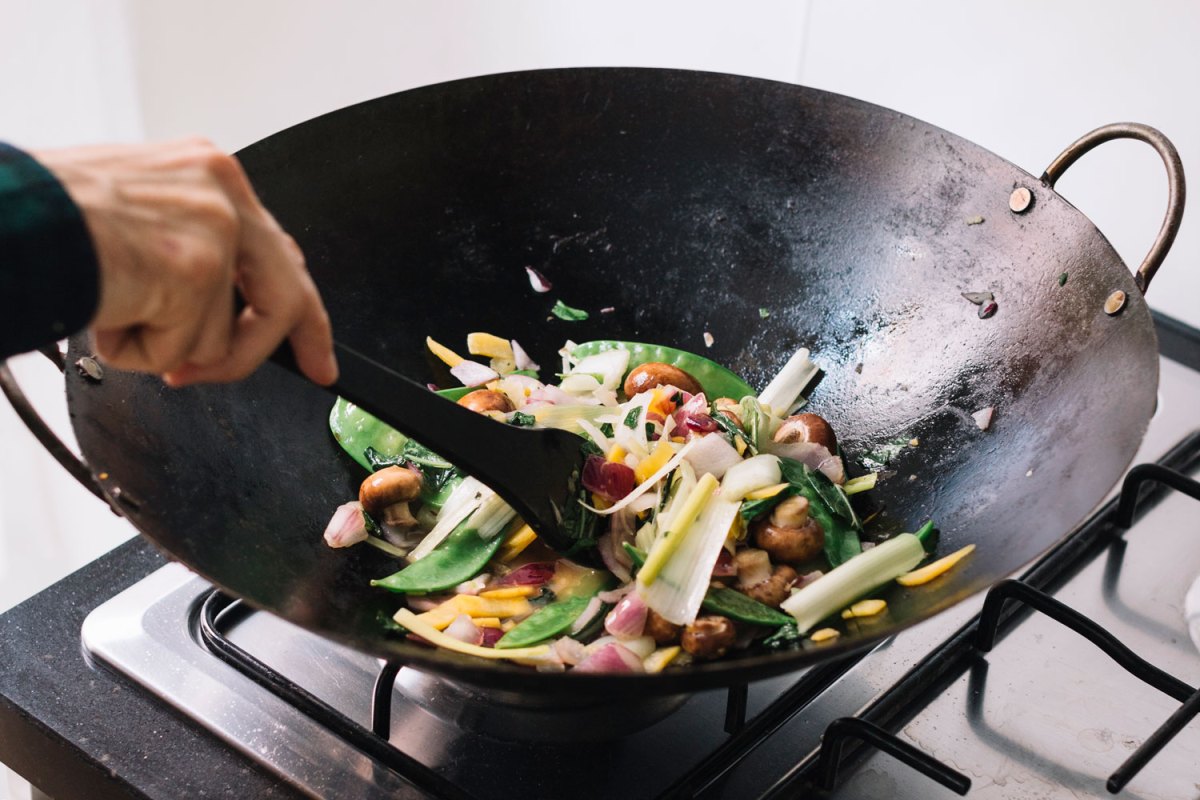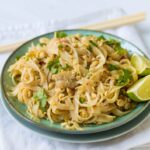Embark on a culinary adventure with vibrant, nut-free stir-fries bursting with flavor! Imagine sizzling woks, fragrant aromas of ginger and garlic, and a kaleidoscope of colorful vegetables dancing with perfectly cooked protein. This exploration dives into the art of creating delicious and allergy-friendly stir-fries, offering diverse recipes, insightful ingredient substitutions, and expert techniques to elevate your cooking game. Whether you’re a seasoned chef or a kitchen novice, you’ll discover the secrets to crafting stir-fries that are both healthy and incredibly satisfying.
We’ll journey through three distinct culinary landscapes – Thai, Chinese, and Vietnamese – each showcasing unique flavor profiles and ingredient combinations. Learn how to seamlessly replace common nut-based ingredients with equally delicious nut-free alternatives, ensuring texture and taste remain paramount. Master the art of stir-frying, from precise knife skills to achieving that perfect balance of crisp-tender vegetables and succulent protein. Finally, we’ll explore creative serving suggestions and customization options, empowering you to adapt these recipes to your own dietary preferences and culinary creativity.
Nut-Free Stir-Fry Recipe Variations

These three nut-free stir-fry recipes offer a vibrant exploration of Asian cuisine, showcasing diverse flavor profiles and textures without relying on nuts. Each recipe provides a balanced and healthy meal, rich in vegetables and lean protein.
Thai Green Curry Stir-Fry
This vibrant stir-fry bursts with the aromatic flavors of Thai green curry paste, delivering a creamy, yet nut-free, experience.
Ingredients: 1 tbsp coconut oil, 1 lb firm tofu (pressed and cubed), 1 red bell pepper (sliced), 1 green bell pepper (sliced), 1 cup broccoli florets, 1 cup snow peas, 1/2 cup bamboo shoots, 2 tbsp green curry paste, 1/4 cup coconut milk (full-fat), 2 tbsp soy sauce, 1 tbsp brown sugar, 1 lime (juiced), chopped cilantro for garnish.
Instructions: 1. Heat coconut oil in a wok or large skillet over medium-high heat. Add tofu and cook until golden brown, about 5 minutes. 2. Add bell peppers and broccoli; stir-fry for 3 minutes. 3. Stir in green curry paste and cook for 1 minute. 4. Add coconut milk, soy sauce, and brown sugar; bring to a simmer. 5. Add snow peas and bamboo shoots; cook until tender-crisp, about 2 minutes. 6. Stir in lime juice and garnish with cilantro.
Chinese Sesame Ginger Stir-Fry
This recipe offers a savory and subtly sweet experience, characteristic of Chinese cuisine, without the use of any nuts. The ginger and sesame oil create a fragrant and delicious base.
Ingredients: 1 tbsp sesame oil, 1 lb boneless, skinless chicken breast (sliced), 1 inch ginger (minced), 2 cloves garlic (minced), 1 red onion (sliced), 1 cup mushrooms (sliced), 1 cup bok choy (chopped), 1/2 cup snow peas, 2 tbsp soy sauce, 1 tbsp rice vinegar, 1 tbsp honey, 1 tsp sesame seeds for garnish.
Instructions: 1. Heat sesame oil in a wok or large skillet over medium-high heat. Add chicken and cook until browned. 2. Add ginger and garlic; stir-fry for 1 minute. 3. Add red onion and mushrooms; stir-fry for 3 minutes. 4. Add bok choy and snow peas; stir-fry for 2 minutes. 5. Stir in soy sauce, rice vinegar, and honey. 6. Garnish with sesame seeds.
Vietnamese Lemongrass Stir-Fry
This refreshing stir-fry showcases the bright, citrusy notes of lemongrass, a key ingredient in Vietnamese cooking. The combination of lemongrass, garlic, and fish sauce creates a unique and flavorful sauce.
Ingredients: 1 tbsp coconut oil, 1 lb shrimp (peeled and deveined), 2 stalks lemongrass (finely chopped), 3 cloves garlic (minced), 1 red chili (finely chopped), 1 cup carrots (julienned), 1 cup bean sprouts, 1/4 cup fish sauce, 2 tbsp lime juice, 1 tbsp brown sugar, chopped fresh mint and cilantro for garnish.
Instructions: 1. Heat coconut oil in a wok or large skillet over medium-high heat. Add shrimp and cook until pink. 2. Add lemongrass, garlic, and chili; stir-fry for 1 minute. 3. Add carrots; stir-fry for 2 minutes. 4. Stir in fish sauce, lime juice, and brown sugar. 5. Add bean sprouts; cook until just wilted. 6. Garnish with mint and cilantro.
Nutritional Comparison
The following table provides a comparative nutritional analysis (approximate values per serving) of the three stir-fry recipes. Note that these values can vary based on specific ingredients and portion sizes.
| Recipe | Protein (g) | Fiber (g) | Vitamins (Examples) |
|---|---|---|---|
| Thai Green Curry | 20-25 | 8-10 | Vitamin C (from peppers), Vitamin A (from carrots – if added) |
| Chinese Sesame Ginger | 30-35 | 6-8 | Vitamin B6 (from chicken), Vitamin K (from bok choy) |
| Vietnamese Lemongrass | 25-30 | 7-9 | Vitamin C (from chili and carrots), Vitamin A (from carrots) |
Ingredient Substitutions and Alternatives
Creating delicious and flavorful nut-free stir-fries requires thoughtful substitutions for common nut-based ingredients. Many stir-fry recipes rely on nuts for both their textural contribution (crunch, creaminess) and their flavor profile (nutty, savory, sweet). Successfully replacing these ingredients requires understanding the role the nut plays in the dish and choosing an alternative that mimics those qualities as closely as possible.
Many stir-fries incorporate nuts for richness, texture, and flavor. Substituting these ingredients requires careful consideration of the desired final product. Simply swapping one ingredient for another without understanding the impact can drastically alter the taste and mouthfeel. The following substitutions focus on maintaining the overall balance and integrity of the stir-fry.
Nut-Based Ingredients and Their Nut-Free Counterparts
Several common nut-based ingredients frequently appear in stir-fries, each offering a unique textural and flavor profile. Their nut-free alternatives, while not identical, can provide satisfying substitutes.
- Peanut Butter: Often used as a sauce base, peanut butter contributes richness and a savory-sweet flavor. Sunbutter (sunflower seed butter) offers a similar creamy texture and mild, slightly sweet flavor, although it lacks the intense peanut flavor. Tahini (sesame seed paste) provides a bolder, more robust flavor, with a slightly bitter edge and a less sweet profile. For a completely different flavor profile, consider using a creamy cashew-free nut-free alternative, or even a smooth pumpkin puree for a sweeter, earthier taste.
- Cashews: Whole cashews add a delightful crunch and creamy texture when stir-fried. Pumpkin seeds offer a similar crunch, though with a slightly less intense flavor. Sunflower seeds provide a lighter crunch and a milder, slightly sweet flavor. Alternatively, consider using roasted chickpeas for a more substantial crunch and a unique, slightly earthy flavor.
- Almonds: Sliced almonds provide a satisfying crunch and a slightly bitter, nutty flavor. Toasted pepitas (pumpkin seeds) offer a comparable crunch but with a sweeter, less bitter taste. For a different textural experience, consider using toasted coconut flakes for a delicate sweetness and a pleasant crunch. If you want a similar texture but a completely different flavor, try using crispy fried tofu.
- Peanut Oil: Frequently used for its high smoke point and subtle nutty flavor, peanut oil can be replaced with other high-smoke-point oils like avocado oil, grapeseed oil, or refined coconut oil. These oils will not impart a nutty flavor, but they will allow for high-heat cooking without compromising the stir-fry’s quality.
Selecting the Best Nut-Free Substitute
The optimal nut-free substitute depends heavily on the specific role the nut plays in the stir-fry. Consider the following:
If the nut provides primarily texture, focus on finding a substitute with a similar crunch or creaminess. If flavor is paramount, select a substitute with a complementary flavor profile.
For instance, if a recipe calls for cashews for their creamy texture, sunflower seed butter might be a suitable replacement. If the recipe relies on almonds for their crunchy texture and subtle bitterness, pepitas might be a good choice. However, if the recipe uses peanuts for their distinctive savory-sweet flavor, finding a perfect match might require a blend of substitutes or adjusting the seasoning profile of the dish. Experimentation and a willingness to adapt are key to achieving delicious and satisfying nut-free stir-fries.
From the fragrant sizzle of the wok to the vibrant colors on your plate, mastering the art of nut-free stir-fries is a rewarding culinary journey. This guide has equipped you with the knowledge and techniques to create flavorful, allergy-friendly meals that are both visually stunning and incredibly delicious. Experiment with different ingredients, explore diverse flavor combinations, and most importantly, have fun in the kitchen! The possibilities are endless, and your taste buds will thank you.
Quick FAQs
Can I make these stir-fries ahead of time?
While stir-fries are best enjoyed fresh, you can prepare the vegetables and protein in advance. Store them separately in airtight containers in the refrigerator. Assemble and cook the stir-fry just before serving for optimal texture and flavor.
What are some good sources of protein for nut-free stir-fries?
Excellent protein choices include tofu, tempeh, chicken, shrimp, beef, and seitan. Choose a protein that complements the flavor profile of your chosen stir-fry.
How do I prevent my stir-fry from becoming soggy?
Ensure your wok or pan is hot before adding ingredients. Don’t overcrowd the pan; work in batches if necessary. Stir-fry quickly over high heat to maintain the crispness of the vegetables.
Can I freeze nut-free stir-fries?
It’s best not to freeze stir-fries as the texture can change upon thawing. It’s best to prepare fresh.


